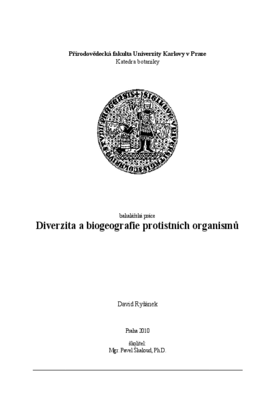Diverzita a biogeografie protistních organismů
Diversity and biogeography of protists
bakalářská práce (OBHÁJENO)

Zobrazit/
Trvalý odkaz
http://hdl.handle.net/20.500.11956/29945Identifikátory
SIS: 79116
Katalog UK: 990012746180106986
Kolekce
- Kvalifikační práce [21483]
Autor
Vedoucí práce
Oponent práce
Kulichová, Jana
Fakulta / součást
Přírodovědecká fakulta
Obor
Biologie
Katedra / ústav / klinika
Katedra botaniky
Datum obhajoby
8. 6. 2010
Nakladatel
Univerzita Karlova, Přírodovědecká fakultaJazyk
Čeština
Známka
Výborně
Klíčová slova (česky)
abundance, biogeografie, diverzita, Klebsormidium, protistaKlíčová slova (anglicky)
abundance, biogeography, diversity, Klebsormidium, protistsPředložená bakalářská práce sestává ze dvou částí. První částí je literární rešerše, druhou částí je pak praktická kapitola, která obsahuje výsledky mého vlastního výzkumu. V první části mé bakalářské práce se věnuji literární rešerši, ve které se zabývám dvěma současnými názory na biodiverzitu a biogeografii protist. První hypotézou je model ubikvitního rozšíření, který popisuji v několika bodech a ilustruji několika příklady. Podobně jsem představil i druhou teorii umírněného ubikvitního modelu. V závěru oba modely srovnávám a poukazuji na výhody a nevýhody jednotlivých teorií. Ve druhé části své bakalářské práce stručně charakterizuji rod Klebsormidium a následně popisuji optimalizaci molekulárních metod, které mi umožní studium biodiverzity a biogeografie tohoto rodu v rámci mé diplomové práce.
My bachelor thesis consists of two parts. The first part is a literature review, the second part is a practical one, which contains the results of my own research. The first part of my thesis is devoted to the literature review, dealing with two current views on biodiversity and biogeography of protists. The first theory, model of protist ubiquity is described in a few points and illustrated by several examples. Likewise is presented the second hypothesis of moderate endemicity model. In conclusion, both models are compared and advantages and disadvantages of each theory are pointed out. In the second part of this thesis I briefly describe the genus Klebsormidium, which is followed by an optimization of molecular methods to study biodiversity and biogeography of this genus.
